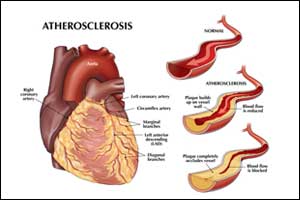- Home
- Editorial
- News
- Practice Guidelines
- Anesthesiology Guidelines
- Cancer Guidelines
- Cardiac Sciences Guidelines
- Critical Care Guidelines
- Dentistry Guidelines
- Dermatology Guidelines
- Diabetes and Endo Guidelines
- Diagnostics Guidelines
- ENT Guidelines
- Featured Practice Guidelines
- Gastroenterology Guidelines
- Geriatrics Guidelines
- Medicine Guidelines
- Nephrology Guidelines
- Neurosciences Guidelines
- Obs and Gynae Guidelines
- Ophthalmology Guidelines
- Orthopaedics Guidelines
- Paediatrics Guidelines
- Psychiatry Guidelines
- Pulmonology Guidelines
- Radiology Guidelines
- Surgery Guidelines
- Urology Guidelines
Genes to Medicine - An Injection to reverse atherosclerosis

Injection of microscopic fibers may help in the reversal of atherosclerosis that in turn will eliminate the need for any invasive therapy for treatment of the disease, according to a preliminary research presented at the American Heart Association's Vascular Discovery: From Genes to Medicine Scientific Sessions 2018, a premier global exchange of the latest advances in vascular biology for researchers and clinicians.
The study was conducted by Neel A. Mansukhani and colleagues to develop a non-invasive, non-surgical, novel therapy to halt and reverse atherosclerosis by actually targeting the vessel wall with peptide-based nanofibers developed in the laboratory. The tiny fibers contained particles that helped remove cholesterol deposits from the plaque in the artery walls.
Atherosclerosis is a condition characterized by a narrowing and hardening of arteries and blood vessels due to the accumulation of a hard, waxy substance called plaque, which is rich in cholesterol.
Drugs such as statins are used to control low density lipoprotein (LDL) the so-called bad cholesterol and thus decrease "plaque burden", explained Dr. Mansukhani, M.D. lead author of the study and an integrated vascular surgery fellow at Northwestern University Feinberg School of Medicine in Chicago. "But statins have not been proven to reverse the disease." Mansukhani said.
Other treatment approaches for atherosclerosis, which can narrow blood vessels and arteries throughout the body, include bypass surgery and stenting, but neither reverses the disease and each can cause damage to the vessel wall, he said.
Researchers synthesized self-assembling peptide amphile nanofibers that targeted areas of plaque and could be delivered by intravenous injection. Importantly these synthetically engineered nanofibers contained an amino acid sequence that promotes the cholesterol to dissolve.
To test the concept, mice were genetically modified to rapidly develop atherosclerosis, then fed high fat diets for 14 weeks and after which the mice received biweekly injections of either the peptide amphile nanofiber or saline for 8 weeks.
Imaging techniques of fluorescent microscopy and pixel quantification were used for determination of the optimum dose, concentration, binding duration and biodistribution. Following which, the investigators observed the targeting effect after 24 hours, and after 48 to 72 hours the nanofiber would dissipate and it was cleared in 7 to 10 days.
After 8 weeks of treatment, plaque area in the arteries of the male mice was reduced by 11 percent and in the female mice by 9 percent.
The results "demonstrate that a novel targeted nanofiber binds specifically to atherosclerotic lesions and reduces plaque burden after a short treatment duration," Mansukhani said.
He noted, however, that this is preliminary research, and more is needed before this approach can be tested in humans.
"Injecting microscopic fibers that remove plaque deposits from artery walls reversed atherosclerosis," concluded the authors.

Disclaimer: This site is primarily intended for healthcare professionals. Any content/information on this website does not replace the advice of medical and/or health professionals and should not be construed as medical/diagnostic advice/endorsement or prescription. Use of this site is subject to our terms of use, privacy policy, advertisement policy. © 2020 Minerva Medical Treatment Pvt Ltd